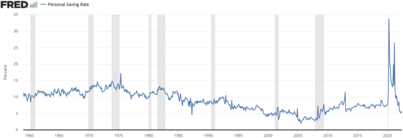
Back Spaar AF مدخرات Arabic Qənaət AZ Спестяване Bulgarian Espern BR Estalvi Catalan Spoření Czech Opsparing Danish Sparen German Αποταμίευση Greek
This article has multiple issues. Please help improve it or discuss these issues on the talk page. (Learn how and when to remove these messages)
|

Saving is income not spent, or deferred consumption. In economics, a broader definition is any income not used for immediate consumption. Saving also involves reducing expenditures, such as recurring costs.
Methods of saving include putting money in, for example, a deposit account, a pension account, an investment fund, or kept as cash.[1] In terms of personal finance, saving generally specifies low-risk preservation of money, as in a deposit account, versus investment, wherein risk is a lot higher. Saving does not automatically include interest.
Saving differs from savings. The former refers to the act of not consuming one's assets, whereas the latter refers to either multiple opportunities to reduce costs; or one's assets in the form of cash. Saving refers to an activity occurring over time, a flow variable, whereas savings refers to something that exists at any one time, a stock variable. This distinction is often misunderstood, and even professional economists and investment professionals will often refer to "saving" as "savings".[2]
In different contexts there can be subtle differences in what counts as saving. For example, the part of a person's income that is spent on mortgage loan principal repayments is not spent on present consumption and is therefore saving by the above definition, even though people do not always think of repaying a loan as saving. However, in the U.S. measurement of the numbers behind its gross national product (i.e., the National Income and Product Accounts), personal interest payments are not treated as "saving" unless the institutions and people who receive them save them.
Saving is closely related to physical investment, in that the former provides a source of funds for the latter. By not using income to buy consumer goods and services, it is possible for resources to instead be invested by being used to produce fixed capital, such as factories and machinery. Saving can therefore be vital to increase the amount of fixed capital available, which contributes to economic growth.
However, increased saving does not always correspond to increased investment. If savings are not deposited into a financial intermediary such as a bank, there is no chance for those savings to be recycled as investment by business. This means that saving may increase without increasing investment, possibly causing a short-fall of demand (a pile-up of inventories, a cut-back of production, employment, and income, and thus a recession) rather than to economic growth. In the short term, if saving falls below investment, it can lead to a growth of aggregate demand and an economic boom. In the long term if saving falls below investment it eventually reduces investment and detracts from future growth. Future growth is made possible by foregoing present consumption to increase investment. However, savings not deposited into a financial intermediary amount to a loan (interest-free) to the government or central bank, who can recycle this loan.
In a primitive agricultural economy, savings might take the form of holding back the best of the corn harvest as seed corn for the next planting season. If the whole crop were consumed the economy would convert to hunting and gathering the next season.
- ^ "Random House Unabridged Dictionary." Random House, 2006
- ^ "Savings Rate". Investopedia. Retrieved 27 August 2014.